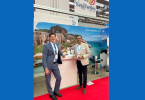Moonshot thinking and advanced photovoltaics were among the non-travel phrases setting the tone for the opening day of this year’s Travel Forward.
Becky Power from Google started the two-day conference by explaining how Google’s parent company Alphabet has formalised its big picture thinking under a business unit called X.
During her presentation, she introduced “moonshot thinking” as a description of how Google, X and the parent company approach this. To make the concept real, she talked about Sidewalk Labs, a unit dedicated to smart cities. The lab’s aim is to “re-imagine how cities work, how planning, people, processes and technology can work together to create better living and working environments”.
Sidewalk is looking closely at how autonomous and self-driving vehicles can change the space needed for car storage, how new materials and design can reduce construction costs for residential and commercial properties, how sustainability can be embedded into any decision and the role of data and connectivity.
Sidewalk is already working with cities such as Toronto to the develop the future of urban landscapes for the better.
Power was then able to frame the moonshot approach for a travel and hospitality audience. She suggested that once a problem had been identified, travel companies need to come up with a long-term solution for the problem, collaborate with like-minded people, look at new tech and be able to have a structure in place to allow rapid experimentation.
Meanwhile, Harj Dhaliwal from Virgin Hyperloop One, explained the theory and practice of hyperloop technology and how it has the potential to disrupt travel by massively reducing point to point connection times with its a top speed in excess of 1000 kilometres per hour.
The technology combines new composite materials and enhanced magnetic levitation and propulsion systems. The capsules travel within a constructed tunnel, where a vacuum is created to reduce resistance. The disciplines needed to deliver on this include energy storage using photovoltaics, materials science and autonomous mobility. Successful trials have taken place already, showing it might not be too long before this becomes a realistic travel opportunity.
Like Power before, Dhaliwal argued that the hyperloop has the potential to radically change the way we develop cities. He talked about plans under discussion in India, which would see a hyperloop developed alongside the existing rail infrastructure, reducing the connection time between Pune and Mumbai from three-and-a-half hours to 25 minutes.
The ability of the hyperloop to disrupt aviation by offering significantly shorter journey times is the most obvious impact it could have on travel, but Dhaliwal also talked about “super-hub airports”, created when two airports in the same city are connected by hyperloop. Airports, he said, could become smaller with fewer runways if these hyperloop connections between them became viable.
The costs of the project so far, and the ticket price for travellers, were not touched on, with some questions from the floor asking about land acquisition costs and governmental buy-in.
Richard Gayle Senior Director, Travel Forward, said: “This was a strong start to the conference, encouraging attendees to look outside of the industry for inspiration.
“It was great for the audience to hear about some of the initiatives that Google’s parent company is undertaking, and how its attitude to solving big problems can provide a template for travel companies to approach their own issues.
“Similarly, the potential influence of Hyperloop One is a reminder that travel and technology never stands still.”
eTN is a media partner for WTM London.






